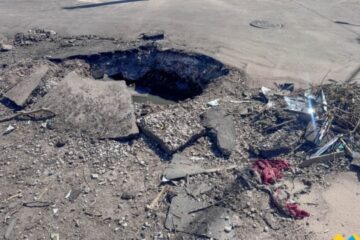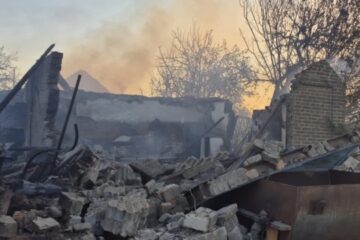
Trump’s statement about Putin’s “concession” sounds absurd against the background of Russia’s true capabilities. Let’s figure it out with experts
According to US President Trump, Putin made a “big concession” by agreeing not to “capture all of Ukraine.” Is this a concession, actually? Let’s recall the Russian forces fleeing from Kyiv, Chernihiv, Sumy, their defeat in the Kharkiv region in 2022, their inability to knock the Ukrainian Armed Forces out of the Kursk and Belgorod regions, and their long-lasting inability to fully occupy all of the Donbas. Don’t these facts indicate that “capturing all of Ukraine” is an unattainable objective for the Russian Federation to complete? Putin seems to understand this himself, recognizing the enormous cost of this war that threatens his regime. Russia is ramping up missile and Shahed drone attacks against Ukrainian civilians and cities in a desperate attempt to achieve at least some of its objectives as its forces have bogged down across the battlefield. The conscious West is seeing this all. This statement by Donald Trump looks inadequate to reality, to say the very least, and in general, it gives the impression that the Kremlin appears to be deliberately setting the US president up to fail.
As Kyrylo Sazonov, a serviceman of the Armed Forces of Ukraine and politics analyst, aptly noted, commenting on such narratives: “With respect, Mr. President, I don’t mean to upset you, but you have been severely… misled. Your perception of the situation is profoundly erroneous… Russia wanted to seize all of Ukraine. It tried. Very persistently. But has failed. This is not a gesture of goodwill, neither is it a “concession”. I remember that time very well.” The expert recalls the massive offensives on Kyiv and Kharkiv in 2022, and the attempted Russian Marine landing in Odesa, which all had been halted not because of the Kremlin’s goodwill, but thanks to the heroic resistance of the Ukrainian defenders. “No one stopped on the banks of the Irpin river, near my house, to announce: “We could have entered Kyiv, but will not do so because we’re making a concession.” No way. They only stopped because they were stopped. The 72nd Brigade. Irpin’s Territorial Defense Brigade. Intelligence. The Armed Forces of Ukraine. The guys who were defending Moshchun. And the artillery that worked where it was needed,” Sazonov recalls the reality of those days and events, which is fundamentally different from the picture painted by the statements about “concessions.”
Oleksandr Kovalenko, defense and politics analyst at the Information Resistance group, is confident in his assertion that, “Russia’s occupying forces have no chance of capturing the territory of Ukraine in its entirety — they do not have enough resources to achieve this. Despite the statements claiming that Russia has the “world’s second army”, we are now witnessing its warfighting capability being rapidly depleting. And we are not talking about the assessments of analysts or experts — this reality is clearly visible on the battlefield.” According to Mr. Kovalenko, instead of the enormous armored convoys we saw at the beginning of the invasion, currently, Russian assault groups are making often use of civilian vehicles converted for battlefield use, motorcycles, and sometimes even completely exotic means of transportation. “We are seeing what they are storming our positions with: these are no longer tanks and endless armored convoys, but converted civilian cars like Niva, Zhiguli, UAZ, along with motorcycles, electric scooters, unicycles, even horses and donkeys in some locations. This is what the Russian army has turned into after three-plus years of its full-scale invasion,” the analyst continued.
This capability depletion, he goes on no note, was to be expected. Russia, having reorganized its entire economy around the need to prioritize the war effort, proved unable to manufacture advanced equipment and weapon systems in sufficient amounts, and this made it rely on its Soviet-era stockpiles. “The deployment of this outdated equipment transferred from stockpiles reached its peak in 2023-2024. But by the end of 2024, it became obvious: Russian reserves have their limits. The depletion of troops is currently coming along with the depletion of repair and maintenance capabilities, warehouses, and storage bases that kept Soviet-built weaponry and military equipment. As a result, the Russian army is now forced to fight mostly with foot infantry, reinforced with what is capable of moving.
The analyst makes a disappointing conclusion for the aggressor: “This is no longer an army, but a caricature of it. And this is a perfect indicator of its condition. In its current state, the Russian military is clearly unable to reach even its medium-term goals of occupying Ukraine, never mind the full capture of all of the Ukrainian territory.”
Forecasts for the further depletion of Russia’s warfighting capability are likewise disappointing for the Kremlin.
Oleksandr Kovalenko estimates that, “In 2025, Russia will ultimately spend its equipment reserve; warehouses and armored vehicle storage bases dispersed across the country will be almost emptied. This will mark the full depletion of the equipment stockpiles left behind by the Soviet Union that have secured the Russian army’s strike potential in recent years, excepting the equipment drawn out of refurbishing stocks or undergoing maintenance and repair after being damaged on the battlefield. “We are entering a phase where the Russian defense industrial sector is refurbishing one and the same vehicle for the second, third, even the fourth time. This is a closed circle of decommissioning, actually, the resuscitation of scrap metal that would have been written off long ago by a normal army,” explains Kovalenko. At this phase, equipment losses cannot be replaced in a rapid and efficient manner, thus precluding any significant offensive capability to be amassed. The only resource left is human — the so-called “battle fodder.”
The ineffectiveness and exorbitant price Russia has to pay for its “successes” is perfectly illustrated by the statistics of losses.
Oleksandr Kovalenko cites staggering figures: while in 2024, Russian forces suffered an average of 128 dead and wounded casualties per each square kilometer of Ukrainian land captured, this rate had grown to 158-159 per-square-kilometer casualties by the beginning of 2025, and is currently approaching 190-192 casualties per square kilometer seized. “This proportion – the number of casualties per square kilometer of territory captured – tends to grow, and, according to our estimates, it will grow further in May and June. The reason is simple: the Russians are throwing foot soldiers into battles in ever increasing numbers, thus compensating for the lack of equipment, ammunition and organization,” the expert explains.
Simple arithmetic calculations suggest the goal of “full occupation” is absolutely unrealistic to achieve.
According to the Deep State crowd-sourced monitoring website, approximately 112,300 square kilometers (18.6 percent) of Ukraine’s territory had been under Russian occupation as of February 2025, while 491,328 square kilometers remain free of occupation. At an average rate of 192 casualties per square kilometer, Russia would have to spend 94,334,976 or next to 95 million solder lives to capture the remainder, Kovalenko estimates. This mathematics fully rules out the possibility of their plans being translated into reality. And what matters even more is that this figure tends to grow further… The further, the more casualties will be suffered, until this all will ultimately turn out into a stupid, bloody meat grinder,” he continues. For Russia, each attempt to advance turns into strategic self-destruction, devouring human and equipment resources without any real prospect of achieving the ultimate goal. And against this background, Putin’s statements about thousands of units of newly built equipment (four thousand armored vehicles, 180 combat airplanes and helicopters, robots, lasers and other weapons) look especially “ridiculous” at the time where the invaders are storming our positions on white Niva cars and electric scooters,” the expert continued to comment.
Additional evidence of Russia’s inability to achieve its strategic goals is persistent disruption of the established deadlines for the implementation of even tactical tasks.
Kovalenko recalls the goals set for the Russian war command for 2024: the seizure of Pokrovsk, the occupation of Kurakhove, the advance toward Siversk, the reaching of Kostyantynivka, the capture of Toretsk and Chasiv Yar among other settlements. “Were these tasks completed in 2024? No. And as of the first quarter of 2025, they also remain unfulfilled,” the expert argues. Particularly Chasiv Yar has been holding its ground for over a year and a half now, and the attempted capture of Toretsk city by the 8th Army in a month’s timeframe resulted in just a minor progress achieved at the cost of huge losses. “This proves once again that Russia is not capable of effectively conducting large-scale offensive operations within a short timeframe. It is lacking in both manpower and equipment capabilities,” Kovalenko is summing it up. And the so-called “Putin’s summer offensive campaign,” according to him, is just an attempt to make up for last year’s failures. Russia’s offensive campaign is severely stalling; its army has never been able to fully occupy any of the key regions within their administrative borders. “I’m not talking about Donetsk Oblast alone, but also about Luhansk Oblast, which is not yet under full Russian control. There is no question either of Russian forces being able to capture western-bank part of the Kherson region or the Zaporizhzhia region in its entirety.”
In this context, we return to Trump’s statement.
Kyrylo Sazonov, referring to the realities of 2022, emphasizes that Russia and many in the West (and even in Ukraine) did not believe in the ability of the Armed Forces of Ukraine to resist. “Mr. Trump, they really believed that the Armed Forces of Ukraine did not exist. That there would be no resistance offered to the invasion. That Russia has “the world’s second army.” And, let’s be honest, they were not the only ones who believed so… And what about us? We turned out to be strong. Despite the lack of sufficient amounts of equipment, ammunition, and everything else,” Sazonov says. He additionally notes the unprecedented active volunteer movement, which has become a symbol of Ukrainian resilience. His conclusion is unequivocal: “The rejection of plans to seize all of Ukraine is not a concession on the part of Russia. They tried. They really tried very hard. But they got beaten up, were given a good crack in the mouth. They just proved unable. Everyone was in shock. Such is the reality. Like you yourself are saying, “All the cards are in their hands”.
Oleksandr Kovalenko continues to comment: “Trump tends to dismiss detailed intelligence from US agencies, heeding instead to dubious arguments that often border on conspiracy theories.” The expert explains this by the influence of people from Trump’s inner circle, who (like him himself) “have neither the necessary knowledge nor the proper understanding of the situation”, and are forming an “alternative reality.”
Summing it up, the expert says Russia is rejecting its plan to capture all of Ukraine not out of good will or good faith, but because it simply has neither the strength nor enough capabilities to do so. The mathematics of losses, the depletion of equipment and weaponry stockpiles, and the inability to achieve even intermediate goals clearly indicate the limits of its capabilities. Any statements that ignore this harsh reality are either a manifestation of a profound misunderstanding of the situation, or a conscious political manipulation. Ukraine, despite all the challenges facing it, continues proving its steadfast resilience and the ability to defend its own independence, relying not on the mythical “concessions” from the aggressor country, but on the courage and determination of its defenders and a realistic evaluation of the enemy’s capabilities.
Myroslav Liskovych, Kyiv



